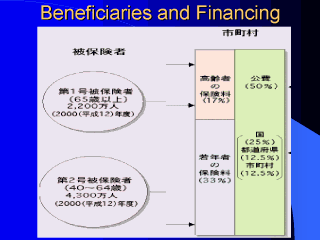| front |1 |2 |3 |4 |5 |6 |7 |8 |9 |10 |11 |12 |13 |14 |15 |16 |17 |18 |19 |20 |21 |22 |23 |24 |25 |26 |27 |28 |29 |30 |31 |32 |33 |34 |35 |36 |review |
 |
Although Japan's LTCI
may be classified as social insurance, it is an amalgam of both German and British models
in terms of financing, i.e. half of the finance comes from tax and the half comes from
premium contribution. Insurance premium is levied on all beneficiaries but the method of
levying varies between the two categories of beneficiaries. For the beneficiary I, most of whom are pensioners, the premium is withheld from their pension payment. For the beneficiary II, most of whom are working class, the premium is levied by health insurers by adding on the health insurance premium. There are a small number of beneficiary I who do not receive pension. They are required to pay voluntarily to the municipal governments. The picture shown illustrates the financial structure of the LTCI. Half [painted green] comes from tax, and premium contribution from elderly [beneficiaries I, pink] and younger population [beneficiaries II, blue]. |